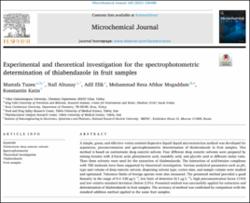| dc.contributor.author | Tüzen, Mustafa | |
| dc.contributor.author | Altunay, Nail | |
| dc.contributor.author | Mogaddam, Mohammad RezaAfshar | |
| dc.contributor.author | Elik, Adil | |
| dc.contributor.author | Katin, Konstantin | |
| dc.date.accessioned | 2022-05-11T14:43:19Z | |
| dc.date.available | 2022-05-11T14:43:19Z | |
| dc.date.issued | 2021 | tr |
| dc.identifier.citation | Tokat Gaziosmanpasa University, Chemistry Department, 60250 Tokat, Turkey b King Fahd University of Petroleum and Minerals, Research Institute, Center for Environment and Water, Dhahran 31261 Saudi Arabia c Sivas Cumhuriyet University, Department of Chemistry, TR-58140, Sivas, Turkey d Food and Drug Safety Research Center, Tabriz University of Medical Science, Tabriz, Iran e Pharmaceutical Analysis Research Center, Tabriz University of Medical Science, Tabriz, Iran f Institute of Nanoengineering in Electronics, Spintronics and Photonics, National Research Nuclear University “MEPhI”, Kashirskoe Shosse 31, Moscow 115409, Russia | tr |
| dc.identifier.uri | https://hdl.handle.net/20.500.12418/12838 | |
| dc.description.abstract | A simple, green, and effective vortex-assisted dispersive liquid–liquid microextraction method was developed for separation, preconcentration and spectrophotometric determination of thiabendazole in fruit samples. This method is based on zwitterionic deep eutectic solvent. Four different deep eutectic solvents were prepared by mixing betaine with 2-furoic acid, phenylacetic acid, mandelic acid, and glycolic acid at different molar ratio. Then these solvents were used for the extraction of thiabendazole. The interaction of acid-betaine complexes with TBZ molecule have been supported by theoretical investigation. Various analytical parameters such as pH, type and volume of deep eutectic solvent, dispersing solvent type, vortex time, and sample volume were studied and optimized. Tolerance limits of foreign species were also measured. The presented method provided a good linearity in the range of 0.4–150 µg L−1, low limit of detection (0.1 µg L−1), high preconcentration factor (1 5 0) and low relative standard deviation (below 2.5%). Presented method was successfully applied for extraction and determination of thiabendazole in fruit samples. The accuracy of method was confirmed by comparison with the standard addition method applied to the same fruit samples. | tr |
| dc.language.iso | eng | tr |
| dc.publisher | Elsevier | tr |
| dc.relation.isversionof | 10.1016/j.microc.2021.106488 | tr |
| dc.rights | info:eu-repo/semantics/closedAccess | tr |
| dc.subject | Zwitterionic deep eutectic solventSpectrophotometerTheoretical investigationThiabendazoleFruit samples | tr |
| dc.title | Experimental and theoretical investigation for the spectrophotometric determination of thiabendazole in fruit samples | tr |
| dc.type | article | tr |
| dc.relation.journal | Microchemical Journal | tr |
| dc.contributor.department | Fen Fakültesi | tr |
| dc.identifier.volume | 168 | tr |
| dc.identifier.issue | 168 | tr |
| dc.identifier.endpage | 106488 | tr |
| dc.identifier.startpage | 106488 | tr |
| dc.relation.publicationcategory | Uluslararası Hakemli Dergide Makale - Kurum Öğretim Elemanı | tr |















